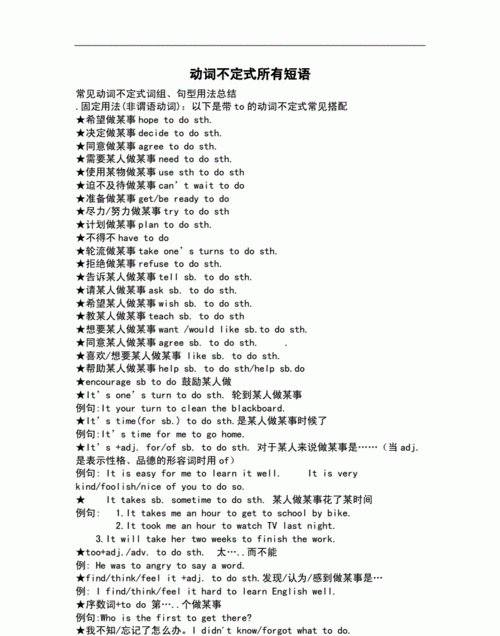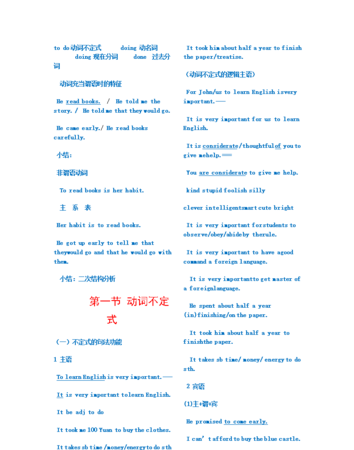本文目录
常见的不定式短语
初中动词不定式整理
一、作主语,可以用it代替,it叫形式主语,动词不定式放在后面叫真正主语
1.To learn a foreign language is not easy.
It is not easy to learn a foreign language.
2. It’s dangerous to drive very fast.
To drive very fast is dangerous.
二、作表语
My idea is to ring him up at once. 我的想法是马上给他打电话。
如果主语部分含实义动词do,且作表语的动词又是“do”的内容,这时表语不定式的“to”可以省略。如:All I did was wait here. 我能做的就是在这里等。
三、常可接动词不定式作宾语的动词有:agree(同意), hope(希望), decide(决定), need(需要), mean(打算), wish(希望), fail(失败), want(想要), begin(开始), would like(想要)等。
He has decided to go to the countryside. 他已决心去乡下。
四、“疑问词 + 动词不定式”结构可以作动词know、think、find out等的宾语。
I don’t know who to ask. 我真不知道该问谁。
五、“疑问词 + 动词不定式”可以作动词show、teach、ask等后面的直接宾语。
She told me where to find the earphone. 她告诉我什么地方可以找到耳机。
六、如果宾语太长,可用it作形式宾语,构成“主语 + 谓语 + it + 宾语不足语(名词或形容词) + to do sth”结构,谓语动词常为find、think、feel等。
I found it difficult to stop him. 我发现拦截他很困难。
七、动词不定式可以作介词的宾语。
Autumn harvest is about to start. 秋收即将开始。
I’m worrying about what to do next. 我正愁下一步该怎么办。
八、作定语的动词不定式与被修饰词有动宾关系。
I have a lot of books to read. 我有许多书要读。
此时,如果动词不定式动词为不及物动词,后面的介词绝对不能省略。
We had only a cold room to live in. 我们只有寒室一间。
九、作定语的动词不定式与被修饰词有主谓关系。
He is always the first to come and the last to leave. 他总是第一个到,最后一个走。
十、作定语的动词不定式与被修饰词之间只有修饰关系。
We have no time to go to town today. 今天我们没有时间去城里。
十一、作状语的动词不定式常表示目的、原因、方向、结果等。
I’m glad to meet you. 见到你,我很高兴。
They ran over to welcome the foreign guests. 他们跑过来欢迎外宾。
十二、不定式复合结构“for sb to do sth”可用作主语、表语、定语、状语等。
It’s for her to decide. 这得由她来决定。(表语)
There are many books for you to read. 这有许多书供你阅读。(定语)
The book is too difficult for children to read. 这本书太难了,孩子们看不懂。(结果状语)
不定式复合结构作主语时,需注意:
It’s + 形容词 + for / of + sb + to do sth.
当上面的形容词指的是to do sth的性质时,用介词for。
It’s dangerous for children to swim in the river. 孩子在这条河里游泳很危险。(游泳这件事情危险)
当上面的形容词指的是sb的性质时,用介词of。这些形容词往往修饰人:good, bad, polite, unkind, kind, nice, clever, right, wrong, careful, careless
It was careless of you to do that. 你这么做真粗心。(你这个人粗心)
十三、动词hear, see, feel, watch, notice, look at, listen to等后面的动词不定式作宾语补足语时不能带to, 即常见的形式为: hear sb do sth等
Many people like to watch others play games. 许多人喜欢看别人玩游戏.
十四、let, make, have后面的动词不定式作宾语补足语, 也不能带to; help后面的动词不定式作宾语补足语, to可有可无
She let us meet her at the station, but she didn’t come. 她让我们去车站迎接她,卡她没有来.
十五、十三和十四这两种情况下的动词不定式在改被动语态句子时,必须将省略的to还原,也就是说,动词后需跟带to的动词不定式.
We heard him sing every day.
He was heard to sing every day. 那时每天都听到他唱歌.
十六、跟带to的动词不定式作宾语补足语的动词还有: ask, beg, leave, like, love, hate, prefer, order, teach, tell, believe, find, know, want, think, understand, would like等
形式为: ask sb to do sth
Would you like me to visit him? 要不要我拜访他?
I would prefer you not to come tomorrow. 我宁愿你明天不要来.
He ask the driver to stop the motobike. 他要那位司机拦下那辆摩托车.
十七、区别下列词组的不同含义:
①like to do sth
like doing sth
②stop to do sth
stop doing sth
③remember to do sth
remember doing sth
④forget to do sth
forget doing sth
十八、It takes sb some time to do sth.花费某人一段时间干某事.
It took me half an hour to do my homework yesterday.昨天我花了半小时做回家作业.
It took Jim an hour and a half to read the book.吉姆花了一个半小时看这本书.
It took mother one and a half hours to do the housework.母亲花了一个半小时干家务.
用汉字表述上面的句型为:It + take + 人 + 一段时间 + to do sth.
一段时间形式往往为像这样的例子:fifteen minutes15分钟,an hour一个小时, two days两天, half a month半个月,a year and a half一年半...等等
十九、不定式的特殊句型too…to…
①too…to 太…以至于…
He is too excited to speak.
他太激动了,说不出话来。
---- Can I help you ? 需要我帮忙吗?
---- Well, I'm afraid the box is too heavy for you to carry it, but thank you all the same. 不用了。这箱子太重,恐怕你搬不动。谢谢您。
②如在too前有否定词,则整个句子用否定词表达肯定, too 后那个词表达一种委婉含义,意 为"不太"。
It's never too late to mend. (谚语)
改过不嫌晚。
③当too 前面有only, all, but时,意思是:非常… 等于very。
I'm only too pleased to be able to help you. 我非常高兴能帮助你。
He was but too eager to get home. 他非常想回家。 二十、不定式的特殊句型Why not
"Why not +动词原形"表达向某人提出建议,翻译为:"为什么不……?" "干吗不……?"
例如:
Why not take a holiday?
干吗不去度假?
21.区别下列词组的不同含义(大家思考完了吗?现在就给您答案吧,对了要知道它们各自的区别哦!)
1 stop to do stop doing
2 forget to do forget doing
3 remember to do remember doing
4 try to do try doing
5 interested to do interested doing
6 begin/ start to do begin/ start doing
7 go on to do go on doing
8 afraid to do afraid doing
9 like to do like doing
22. 给大伙练习,以巩固动词的形式
根据括号内的动词,用适当的形式填空,空内可能不只填一个词,使句子完整意思正确
1. They usually __________ kites on Sundays. (fly)
2. Look! The dogs __________ after the cat. (run)
3. Miss Gao __________ English in our school since she came here. (teach)
4. The class meeting _________ last Wednesday afternoon. (hold)
5. You should let him __________ the work by himself. (finish)
6. Meimei __________ to wash the old woman’s clothes twice every week. (go)
7. Mr Jiang __________ us Chinese last term. (teach)
8. My father __________ back from Japan tomorrow. (come)
9. It’s seven o’clock now. The Greens __________ breakfast together. (have)
10. Jim __________ many Chinese songs since he came to China. (learn)
11. Please remember __________ the window when you leave the room. (close)
12. After school some students began to do some __________ in the classroom. (clean)
13. English __________ widely in the whole world today. (speak)
answer 初中动词不定式整理
1\fly 2\are running 3\has tought 4\was held
5\finish 6\goes 7\tought 8\will come
9\are having 10\has learnt 11\to close
12\cleaning 13\is spoken

动词不定式归纳总结
Ⅰ动词不定式:
动词不定式的时态和语态
1)构成:(以动词“do”为例)
主动态:一般式"to do";完成式"to have done";进行式"to be doing";完成进行式“to have been doing”
被动态:一般式"to be done";完成式“ to have been done"
否定式:not+不定式
2)不定式的时态:
①不定式的一般式表示的动作与主句谓语动词表示的动作同时发生或之后发生。
He seems to know her address.(:=It seems that he knows her address.)
I hope to see you again.(=I hope that I’11 see you again.)
②不定式的进行体表示的动作正在进行,与主句谓语动词表示的动作同时发生。其用法主要有以下几种情况:
a 常用在"appear,happen,pretend,seem,hope,promise"之后。
She pretended to be listening attentively.
Tom appeared to be living in this area.
I hope to be earning my living in a year’s time.(I hope 1 will/would be earning my living)
I promised to be waiting at the door when he came out.b 常用在"believe,consider,suppose,think,know,report,say,understand"等动词的被动式之后。
[注]“be supposed to”通常含有“应该”意思,表示一定的责任和义务。
You are supposed to know how to use a computer=You should know how to use a computer.
Students are not supposed to cook in their dormitory=Students shouldn’t cook in their dormitory.
zh@$OFm dYbA
3)不定式的完成体:
①用于表达发生在主句谓语动词之前的动作或状态,也可以表达预计在将来某一时刻之前完成的动作或状态。
I am sorry to have given you so much trouble.(=I am sorry that I have given you so much trouble.)
C p&n EI)I.OWe’re leaving at five o’clock in the morning,and hope to have done most of the journey by lunchtime.
②不定式完成进行体主要用于“appear,seem,happen,pretend"等之后,也可用于"believe,know,report,say,understand"等动词的被动式之后。
He appears to have been waiting for a long time.
He is believed to have been waiting for a message.
[注]不定式的完成进行体与不定式的完成体略有不同,试比较:
He seems to have eaten the apples.(苹果已被吃光。)
He seems to have been eating the apples.(苹果尚未完全吃光。)
③不定式的完成体还可以表达本该发生却未发生的事情常带这种不定式的谓语动词有:“pretend,intend, appear,seem,should like,expect"等。
I meant to have telephoned you,but I forgot.
4)不定式的语态:
①在不定式之前能找到不定式所表达的动作的执行者时,此不定式用主动态;反之则用被动态试比较:
We found the article hard to understand.(“understand”的执行者是“we”.)
He is reading the article to be published tomorrow.(“punish"之前没有执行者。)
类似的还有:It is impossible to get there.
③在"there be"结构中,不定式既可以用主动态,又可以用被动态。
There is no time to lose/to be lost.(时间紧迫不能耽误了。前后意义无差别。)
④习惯上用“to let(出租)”,“to blame(责怪)”的主动形式表示被动意义。
Tom asked her if she had any rooms to let.(汤姆问她是否有房要出租。)
Ⅱ.分词
分词既具有动词的一些特征(可以有自己的逻辑宾语),又具有形容词(可以作定语、表语、宾补、主补)和副词(状语)的特征。
(1)分词的时态和语态
1)构成:(以动词“do”为例)
①现在分词的构成(V-ing):
主动态:一般式(doing);完成式(having done)
被动态:一般式“being done;完成式(having been done)
否定式:一般式(not doing/not being done);完成式(not having done/not having been done)
[注]“V-ing”分词的被动态结构表示它的逻辑主语是"V-ing"分词所表示的动作的承受者。
Having been invited to speak.I’ll start making preparations this evening.
②过去分词的构成(V-ed):中国雅思网D1Hx0`gH(G QiO
只有一种形式(done),表示被动意义已完成了的动作或状态。1
Considered from this point of view, the question will be of great importance.
2)时态(只有现在分词才有时态形式的变化):
①现在分词的一般式表示动作与主句谓语动词表示的动作同时发生。
He came to visit me,bringing his girl friend with him.
Hearing the good news,she burst into laughing.
②现在分词的完成式表示的动作发生在主句谓语动词表示的动作之前,常用作状语。
Having finished her homework,she went to bed.
Ⅲ.动名词
动名词既具有动词的一些特征(允许有自己的宾语),又具有名词的一些特征(可以作主语、宾语、表语和同位语等)。
动名词的时态与语态
1)构成:与"V-ing"分词的构成相同
2)时态:
①动名词的完成式表示其动作先于谓语动词的动作。
They regret not having taken your advice.
②动名词的一般式也可表示一个先于谓语动词的动作。
I remember seeing a film.
.
①动名词的被动语态表示它的逻辑主语是动名词所表示的动作的承受者。
He dislikes being interrupted during his study.
②动名词的被动态有自己的逻辑主语。
He was so surprised at being discovered that he didn’t even try to run away.

什么叫动词不定式短语
常见动词不定式词组、句型用法总结
.固定用法(非谓语动词):以下是带to的动词不定式常见搭配
★希望做某事hope to do sth.
★决定做某事decide to do sth.
★同意做某事agree to do sth.
★需要某人做某事need to do sth.
★使用某物做某事use sth to do sth
★迫不及待做某事can’t wait to do
★准备做某事get/be ready to do
★尽力/努力做某事try to do sth
★计划做某事plan to do sth.
★不得不have to do
★轮流做某事take one’s turns to do sth.
★拒绝做某事refuse to do sth.
★告诉某人做某事tell sb. to do sth.
★请某人做某事ask sb. to do sth.
★希望某人做某事wish sb. to do sth.
★教某人做某事teach sb. to do sth
★想要某人做某事want /would like sb.to do sth.
★同意某人做某事agree sb. to do sth. .
★喜欢/想要某人做某事 like sb. to do sth.
★帮助某人做某事help sb. to do sth/help sb.do
★encourage sb to do 鼓励某人做
★It’s one’s turn to do sth. 轮到某人做某事
例句:It your turn to clean the blackboard.
★It’s time(for sb.) to do sth.是某人做某事时候了
例句:It’s time for me to go home.
★It’s +adj. for/of sb. to do sth. 对于某人来说做某事是……(当adj.是表示性格、品德的形容词时用of)
例句: It is easy for me to learn it well. It is very kind/foolish/nice of you to do so.
★ It takes sb. sometime to do sth. 某人做某事花了某时间
例句: 1.It takes me an hour to get to school by bike.
2.It took me an hour to watch TV last night.
3.It will take her two weeks to finish the work.
★too+adj./adv. to do sth. 太…..而不能
例: He was to angry to say a word.
★find/think/feel it +adj. to do sth.发现/认为/感到做某事是…
例: I find/think/feel it hard to learn English well.
★序数词+to do 第…..个做某事
例句:Who is the first to get there?
★我不知/忘记了怎么办。I didn't know/forgot what to do.
★ 离开房间时不要忘记/记住关灯
例句:Don’t forget/Remember to turn off the lights when you left the room
★ be+adj+to do sth
例句:1.I am very sorry to hear that.
2.I am ready to help others.
3.I am happy/pleased/glad to meet you.
顺口溜:本领最多不定式,主表定补宾和状;样样成分都能干,只有谓语它不敢;大家千万要小心,有时它把句型改;作主语时用it,自己在后把身藏;七个感官三使役,宾补要把to甩开;疑问词后接上它,宾语从句可充当;逻辑主语不定式,不定式前加for sb.;to前not是否定,各种用法区别开。
以下是不带to的动词不定式(即动词原形)的常见用法
★ let sb. do sth让某人做某事 ★ make do sth使得某人做某事
★ hear do sth do sth听见某人做某事 ★see do sth do sth看见某人做某事
★ why not 或why don’t you +动词原形?为什么不….?(表示建议)
例:Why not/Why don’t you take a walk?
★ 某人+had better( not)do 某人最好(不)做某事
★ 情态动词can/may /must /should+ 动词原形(包括情态动词的否定形式+动词原形)
★ 助动词do/does/did/will/would在构成疑问句或者构成否定句即don’t /doesn’t /didn’t /will not /would not+ 动词原形
★ be going to + 动词原形(表示“即将”“打算” 做某事)
常见动名词、分词的习惯用法总结
使用-ing分词的几种情况
1.在进行时态中。如: 1.He is watching TV in the room.
2.They were dancing at nine o'clock last night.
2.在there be结构中。如:There is a boy swimming in the river.
3.在have fun/problems结构中。如:We have fun learning English this term.
They had problems getting to the top of the mountain.
4.在介词后面。如:Thanks for helping me. Are you good at playing basketball?
What /How about doing sth? 做某事怎么样? I am interested in playing football.
5.在以下结构中
1. enjoy doing sth 喜欢做某事;
2. finish doing sth; 完成做某事;
3. feel like doing sth 想要做某事;
4. stop doing sth 停止做某事(原来的事)
5. forget doing sth 忘记做过某事;
6. go on doing sth 继续做某事(原来的事);
7. remember doing sth 记得做过某事;
8. like doing sth 喜欢做某事;
9. find /see/hear/watch sb doing发现/看到/听到/观看某人做
10. try doing sth 试图做某事;
11. need doing sth 需要做某事;
12. prefer doing sth 宁愿做某事;
13. mind doing sth 介意做某事;
14. miss doing sth 错过做某事;
15. practice doing sth 练习做某事;
16. be busy doing sth 忙于做某事;
17. can't help doing sth 禁不住做某事;
18. waste time/money doing 浪费时间/金钱做…;
19. keep sb.doing 让…始终/一直做…
20. stop sb.(from)doing 阻止某人做某事
21. prefer doing B to doing B=like A better than A喜欢做A更喜欢做B
22. “do some +doing”短语
如:do some shopping/do some washing/do some reading/do some practicing/do some cleaning/do some speaking
23.“go doing”短语去做某事(主要指文娱活动等)
如:go shopping/go fishing/go swimming/go hiking/go skating/go camping/go skiing(滑雪/go boating /go hunting (打猎)

英语动词不定式的用法总结
1.作主语
作主语用的动词不定式常常用it替代,动词不定式(或短语)放在后面。例如:
It's easy to get lost in a big city like Tokyo.在东京这样的大城市容易迷路。
It is terrible to see the ship sinking into the sea.目睹轮船沉入大海,真是太可怕了。
2.作宾语
Indians like to eat hot food.印度人喜欢吃辣味食品。
They need to look at a map.他们需要查看地图。
有的动词不定式在作带有补足语的宾语时,前面往往带有形式宾语it。例如:
Do you think it necessary for us to learn to wait?你认为学会等待对我们来说很必要吗?
They improved the software to make it easier for people to use computers.他们改进了软件,使人们使用计算机更简便了。
3.作表语
It seems to be an interesting book.它看起来是本有趣的书。
The old man's job is to take care of the flowers in the garden.这位老人的工作是照料花园里的花。
4.作宾语补足语
He told me not to bring you anything.他叫我不要给你带任何东西。
Who taught you to play the music?谁教你弹这支曲子的?
5.作定语
动词不定式作定语时,要放在它所修饰的名词或代词后面。例如:
In my dreams I always have very difficult jobs to do.我在梦里总是做一些艰难的工作。
Every day he made one of the smaller animals bring him something to eat.他每天叫一个小动物给他带来吃的东西。
6.作状语
(1)表示目的
You can hide under my seat when the conductor comes to check the tickets.当列车员来查票时,你可以藏在我的座位下面。
In his third year,he left Harvard to work for a company called Microsoft.在三年级时,他为了去微软公司工作而离开了哈佛大学。
(2)表示结果
动词不定式作状语表示结果时常与副词too或enough连用。例如:
It's too heavy to carry.太重了搬不动。
The Californian ship arrived too late to save more people.加利福尼亚号来得太晚,没能挽救更多的人。
7.和某些形容词连用
和动词不定式经常连用的形容词有sure,ready,happy,sorry,afraid等。例如:
He's very happy to see his wife.他见到妻子非常高兴。
I'm sorry to trouble you.很抱歉打扰你了。
8.和疑问词who,what,when,where,which,how构成不定式短语作宾语。例如:
I don't know how to use a computer.我不知道怎样使用计算机。
Can you tell me when to start?你能告诉我什么时候出发吗?

以上就是关于初中动词不定式短语归纳总结 ,常见的不定式短语的全部内容,以及初中动词不定式短语归纳总结 的相关内容,希望能够帮到您。

![参考文献如何设置[][2][3]
,参考文献怎么标注[1-3]](http://yingyu.fuxila.com/assets/v999/images/lazy.png)